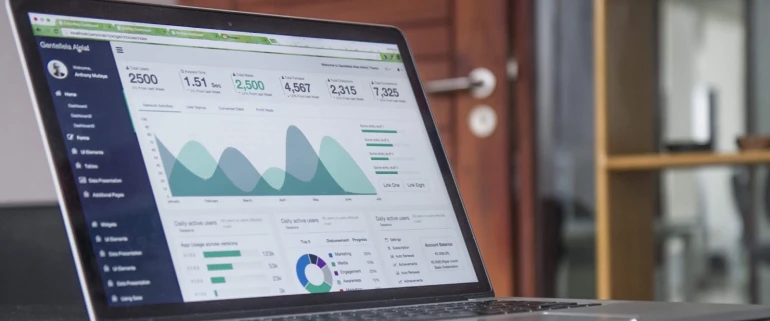.webp)
While using ad exchanges remains a popular choice in digital advertising, there are innovative solutions like the Axis programmatic middleware aimed to increase the effectiveness of the general use of ad exchanges, significantly improving the conventional approach.
Such kinds of solutions don't serve as a direct alternative to traditional ad exchanges; rather, they complement them most effectively, operating in tandem with ad exchanges and enhancing the efficiency and scalability of the usual ad exchange model.
However, let’s start from the very beginning.
What is an ad exchange?
An ad exchange is a platform that organizes the trading of advertising inventory in the digital space.
In essence, an ad exchange connects suppliers looking to monetize their digital properties with advertisers. It operates within the realm of real-time bidding on a programmatic basis, meaning that the buying and selling of ad inventory are done automatically, without the need for human intervention.
How does an ad exchange work?
An ad exchange acts as a trading platform between publishers looking to sell their inventory and advertisers looking for placements to show their ads.
What does the process look like from the publisher's side?
Direct publisher inventory (whether it's mobile apps or websites) is being connected to a technology called a supply-side platform (SSP). To enable SSPs to sell advertising inventory through oRTB, publishers establish connections with an advertising exchange, or more commonly, multiple ones. However, they can also function on a direct sales model.
And what about the advertisers?
To access the needed inventory, advertisers use demand-side platforms (DSPs) to input their campaign needs, from targeting parameters to bid prices. The DSPs, in their turn, also plug into the ad exchanges.
Most ad exchanges sell inventory through open real-time bidding, which means that an ad impression is bid on by numerous advertisers, with the spot going to the highest bidder. While this happens in real time, it feels instantaneous to the viewer. Essentially, while the ad creative is loading on the website you are viewing or in your open mobile application, the auction takes place.

What is Axis?
Axis acts as a programmatic middleware, facilitating smooth connections between suppliers and advertisers to streamline partnership acquisition and trading processes, thereby boosting profitability. As a kind of connector, Axis offers you the opportunity to expand your partner network with its onboarded clients. Importantly, Axis does not insert its node into the selling chain, ensuring there are no additional hops from Axis's side. When collaborating with Axis's clients, you are essentially working with them directly on a technical level.
Is Axis an ad exchange?
No, Axis is not an ad exchange; it is an AI-powered technology that significantly enhances the capabilities of ad exchanges. It enables you to effortlessly expand your client base from both the supply and demand sides. Axis revolutionizes the ad tech landscape by serving as an indispensable enhancement to ad exchanges. Its primary value lies in its ability to automate and streamline critical processes such as contract management, eliminating the need for manual search, negotiation, and signing. With Axis, users can effortlessly expand their clientele, maximize trading efficiency, and benefit from transparent, AI-powered insights — all at their fingertips with just a few clicks.
Axis vs. ad exchange
Axis offers a streamlined solution for programmatic advertising, boasting seamless integration, transparent processes, and efficient trading optimization tools. Unlike traditional ad exchanges, Axis eliminates the complexities of business development, legal hurdles, and costly customizations. Let’s compare them a bit closer.
 | Ad Exchange | |
Integrations and business development | Such partners as Ad exchanges, DSPs, SSPs, publishers, and more can use Axis for traffic management, which is very convenient thanks to a unified interface.
Plus, Axis provides connections to a diverse range of companies for potential partnerships, offering transparent information about their identities and market interests. | Ad Exchange offers several options for the integration of market participants, but these options are typically limited to a few of the most common ones. Any additional integrations would require customization. Additionally, working in an ad exchange requires an investment of time in business development processes – market research, lead generation, establishing business contacts, and more. |
KYC checking and verification processes | The user approval process on Axis includes several stages that involve adding an incorporation certificate and filling out a credit references form after registration, and a few more details. Next, our team verifies info and details about previous collaborations, evaluates it, and approves the account (takes up to 72 hours). | When working on the ad exchange, all the mentioned steps, either fully or partially, users must perform independently for each client. This includes either a high level of manual work, which will require additional financial investments. |
Legal efforts | Axis offers clients a universal contract, IO, which has been carefully vetted by our legal team. Clients can automatically generate our version and use it for legal documentation or use their own contract, automatically pulling it into all offers for potential partners. | Legal processes require the presence of an in-house lawyer who can review the contract from the partner for "pain points and pitfalls," suggest amendments, and then engage in lengthy communication with partners. |
Transparency and Quality of traffic and ads | Transparency in Axis means an open system where clients can see all the details, starting from the partners they are connecting with to the capabilities of these partners (such as the type of traffic and advertising they have). | Information about traffic and demand can only be obtained from the structure of requests and responses that pass through the platform. Therefore, one must know how to handle such information correctly — organize the processing of a huge amount of data and then analyze it. |
Trading optimization | Axis prioritizes technological advancements to streamline trading processes, constantly updating features like KPI optimization and conducting A/B testing for backend improvements, aiming for up to 30% higher effectiveness compared to direct trading. | Traffic optimization, typically managed by an Ad Ops Manager, involves a dedicated team continuously analyzing and optimizing the trading process, including interactions with external traffic partners. |
Cost savings | Axis doesn’t add an additional node, ensuring clients save significant costs by paying only a percentage of their total spend/revenue. Unlike ad exchanges that often impose margins as high as 30% or more, our transparent platform fee offers a cost-effective partnership without additional margin charges for our own profit scaling. | Ad exchanges profit from margin values by adding their servers to the supply chain, increasing prices received from supply partners by a percentage of their margin. This affects the effectiveness of a supply client's traffic monetization, particularly reflected in key metrics like the win rate. |
Billing processes | Axis automates the generation of inter-client invoices, which are available for download at the start of each new month (notifications via the platform and email)
While inter-client billing processes are primarily conducted directly between clients, Axis facilitates communication and monitors payment history to intervene when necessary. | Invoices are generated by the finance team servicing the Ad Exchange platform. The distribution of invoices and reminders about outstanding payments are also done manually. |
Why choose Axis over other similar solutions?
This is a bodacious new product, which means that the platform and our approach are fundamentally lightweight. In contrast to the adage “The heavier the ship, the harder it is to move,” our approach is characterized by flexibility, which permeates every aspect of our project, from internal operations to client onboarding and the implementation of new features.
- We prioritize community engagement, remaining in constant communication with our clients to address any issues they may encounter. Our dedicated Business Consulting and Support Team offers personalized assistance on the platform, complemented by free webinars, educational videos, articles, cases, and other materials where we share valuable advice and insights.
- We boast an experienced technical team with over a decade of expertise in the ad tech sphere. Our primary objective is to surpass direct trading methods, enhancing the overall efficiency of the process.
- Solution is easy to use; users can intuitively grasp how to initiate trading without delving into endless pages of documentation.
- Axis offers a transparent payment model with no additional fees or margin values added.
- Exclusive access to diverse bonuses and personalized offers.
- Flexibility to work with various ad formats and traffic types on Axis.
- No efforts from the business development team needed to locate a relevant partner, no ad operation efforts, no legal efforts, etc.
How does Axis work?
To embark on your journey with Axis, you must first sign up for the platform. The registration process is quick and straightforward, taking only a minute, depending on your Internet connection. Once you have completed registration and verified your email, you can access the platform to fill out your company information. This step is necessary before taking advantage of the extensive features and benefits that Axis offers.
The initial assessment of potential Axis clients is conducted by our Finance Team, which includes:
Website Verification. We verify the client's website to ensure its potential and evaluate the company's position in the market. We also check the company's certificates and compile data from previous partner collaborations.
Thorough Analysis. All information is thoroughly analyzed across various communication channels to ensure there are no negative reviews about the potential client. The entire process takes up to 72 hours, and the more information we receive, the faster the process will be.
Integrations. After approval, the next step is to provide the platform with information about your available integrations. Specify what you are selling through Axis or what inventory you are interested in buying through the platform. Once you share details about your target audience, desired ad placements, and marketing objectives, Axis can better understand your needs and find the perfect match for your ad placements or advertisements using a machine-learning approach.
Getting a list of potential partners. Once all the necessary information is provided, Axis generates a list of potential ad partners that align with your business needs and objectives. The matching process on Axis is complex and works synergistically between numerous factors, starting from your integration details to your status as an Axis client at any given time working on Axis.
Choosing partners. You can then review the list and choose the ad partner that best suits your requirements. With the right partner in place, you can confidently move forward, knowing that your advertising strategy is in good hands.
Generating income. The platform ensures that your message reaches your target audience at the right time and place, maximizing the effectiveness of your advertising campaigns. As a result, you can generate income and enjoy the benefits of a successful marketing strategy
Conclusion: Axis vs. ad exchange platform
In conclusion, while ad exchanges remain a prevalent choice for digital advertising, Axis stands out as a dynamic and innovative middleware that complements and enhances the traditional ad exchange model. By facilitating seamless connections between advertisers and publishers, providing transparent trading processes, and offering personalized support and educational resources, Axis empowers clients to optimize their advertising strategies, expand their networks, and ultimately achieve greater success in the digital advertising landscape.